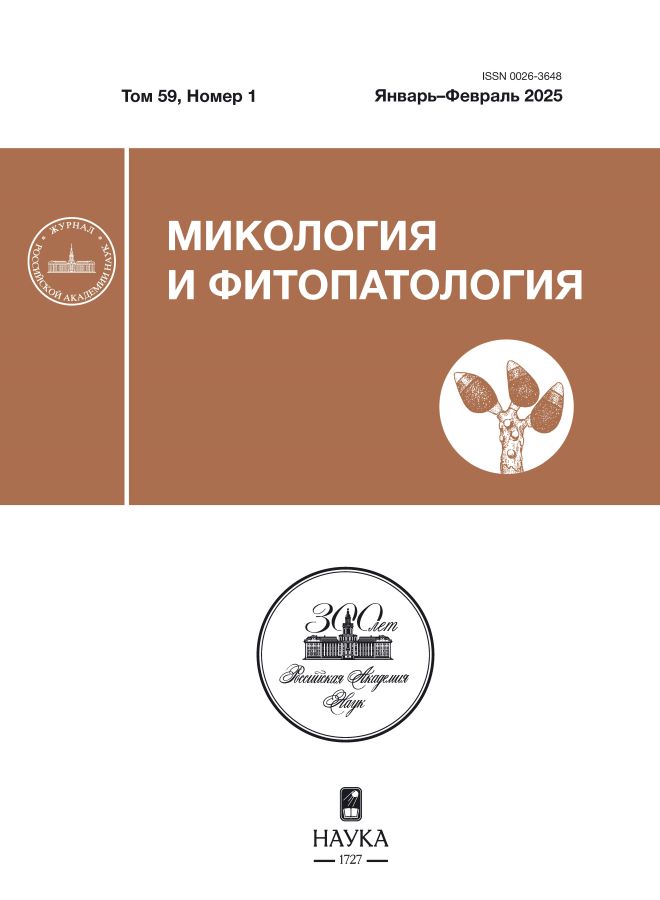Two new for Russia Arrhenia species collected in the Altay Republic, Western Siberia, Russia
- 作者: Gorbunova I.A.1, Filippova N.V.2
-
隶属关系:
- Central Siberian Botanical Garden of the Siberian Branch of the Russian Academy of Sciences
- Yugra State University
- 期: 卷 59, 编号 1 (2025)
- 页面: 27-33
- 栏目: БИОРАЗНООБРАЗИЕ, СИСТЕМАТИКА, ЭКОЛОГИЯ
- URL: https://ruspoj.com/0026-3648/article/view/681163
- DOI: https://doi.org/10.31857/S0026364825010049
- EDN: https://elibrary.ru/srsvek
- ID: 681163
如何引用文章
详细
The article provides information on two new species for Russia, Arrhenia leucotricha and A. subglobisemen, collected in the territory of the Altai Republic. The macro- and micromorphological characteristics of both species were described in detail, and their ITS nrDNA sequences were acquired and analysed. The data on the substrate specificity, ecological preferences in the southern part of Western Siberia, and their geographical distribution in the Holarctic region are discussed.
关键词
全文:
作者简介
I. Gorbunova
Central Siberian Botanical Garden of the Siberian Branch of the Russian Academy of Sciences
编辑信件的主要联系方式.
Email: fungi2304@gmail.com
俄罗斯联邦, Novosibirsk, 630090
N. Filippova
Yugra State University
Email: filippova.courlee.nina@gmail.com
俄罗斯联邦, Khanty-Mansiysk, 628012
参考
- Altschul S.F., Gish W., Miller W. et al. Basic local alignment search tool. J. Molec. Biol. 1990. V. 215 (3). P. 403–410. https://doi.org/10.1016/S0022-2836(05)80360-2
- Barrasa J.M., Rico V.J. The non-omphalinoid species of Arrhenia in the Iberian Peninsula. Mycologia. 2003. V. 95 (4). P. 700–713.
- Blanco Dios J.B. Notes on the genus Arrhenia (I): Arrhenia pontevedrana, sp. nov. and A. subglobisemen (Agaricales, Basidiomycota), from the northwest of the Iberian Peninsula. January Studies in Fungi. 2019. V. 4 (1). P. 185–191. https://doi.org/10.5943/sif/4/1/20
- Bolshakov S., Kalinina L., Palomozhnykh E. et al. Agaricoid and boletoid fungi of Russia: the modern country-scale checklist of scientific names based on literature data. Biological communication. 2021. V. 66 (4). P. 316–325. https://doi.org/10.21638/spbu03.2021.404
- Clémençon H. Methods for working with macrofungi: Laboratory cultivation and preparation of larger fungi for light microscopy. Zurich, 2009.
- Corriol G. Arrhenia subglobisemen, un nouveau nom pour Agaricus tremulus sensu Persoon, Fries. Bull. Trim. Féderation Mycol. Dauphiné-Savoie. 2016. V. 222. P. 5–20.
- Gardes M., Bruns T.D. ITS primers with enhanced specifity for Basidiomycetes: application to identification of mycorrhizae and rusts. Molec. Ecology. 1993. V. 2. P. 113–118.
- GBIF Occurrence Download (Arrhenia subglobisemen). 2024. https://doi.org/10.15468/dl.vprjs2
- Gorbunova I.A. Macromycetes of the alpine region of Altai. Turczaninowia. 2010. V. 13 (3). P. 125–134. (In Russ.).
- Gorbunova I., Filippova N. Fungarium of Gorbunova Irina A. (Central Siberian Botanical Garden, NSK). Yugra State University Biological Collection (YSU BC). 2024. Occurrence dataset. https://doi.org/10.15468/upme2c. Accessed 31.01.24.
- Guindon S., Dufayard J.F., Lefort V. et al. New algorithms and methods to estimate maximum-likelihood phylogenies: assessing the performance of PhyML 3.0. Systematic Biol. 2010. V. 59. P. 307–321.
- Hoang D.T., Chernomor O., Haeseler A. v. et al. UFBoot2: Improving the ultrafast bootstrap approximation. 2017. Molec. Biol. Evol. V. 35 (2). P. 518–522. https://doi.org/10.1093/molbev/msx281
- Ivolov A.V., Bolshakov S. Yu., Silaeva T.V. Study of species diversity of macromycetes. Saransk, Mord. St. University, Saransk, 2017. (In Russ.)
- Kalyaanamoorthy S., Minh B.Q., Wong T. et al. ModelFinder: Fast model selection for accurate phylogenetic estimates. Nature Methods. 2017. V. 14. P. 587–589. https://doi.org/10.1038/nmeth.4285
- Kazutaka K., John R., Kazunori D.Y. MAFFT online service: multiple sequence alignment, interactive sequence choice and visualization. Brief. Bioinformatics. 2019. V. 20 (4). P. 1160–1166. https://doi.org/10.1093/bib/bbx108
- Knudsen H., Vesterholt J. Funga Nordica. Agaricoid, boletoid, clavarioid, cyphelloid and gastroid genera. Nordsvamp, Copenhagen, 2018.
- Koichiro T., Glen S., Sudhir K. MEGA11: Molecular evolutionary genetics analysis. Vers. 11. Molec. Biol. Evol. 2021. V. 38 (7). P. 3022–3027. https://doi.org/10.1093/molbev/msab120
- Nguyen L.T., Schmidt H.A., Haeseler A.V. et al. IQ-TREE: A fast and effective stochastic algorithm for estimating maximum likelihood phylogenies. Molec. Biol. Evol. 2015. V. 32. P. 268–274. https://doi.org/10.1093/molbev/msu300
- Voitk A., Saar I., Lücking R. et al. Surprising morphological, ecological and ITS sequence diversity in the Arrhenia acerosa complex (Basidiomycota: Agaricales: Hygrophoraceae). Sydowia. 2020. V. 73. P. 133–162. https://doi.org/10.12905/0380.sydowia73-2020-0133
- Rambaut А. FigTree v1.4.4. 2006–2018. https://github.com/rambaut/figtree/releases/tag/v1.4.4
- White T.J., Bruns T., Taylor J. Amplification and direct se-quencing of fungal ribosomal RNA genes for phylogenetics. In: M.A. Innis et al. (eds). PCR protocols: a guide to methods and applications, 1990, pp. 315–322.
- Горбунова И.А. (Gorbunova) Макромицеты альпийской области Алтая. Turczaninowia. 2010. № 13 (3). С. 125–134.
- Ивойлов А.В., Большаков С.Ю., Силаева Т.Б. (Ivoylov et al.) Изучение видового разнообразия макромицетов: учеб. пособие. Саранск: Изд-во Мордов. ун-та, 2017. 160 с.
补充文件











